Transport Canada has a helpful page of resources on electric vehicles that includes a link to a map of charging stations.
The map includes a link to a developer API at the US National Renewable Energy Laboratory; by signing up for a free API key you can get the information from the map as JSON or XML.
With the API key, this request will return all the charging stations on Prince Edward Island:
https://developer.nrel.gov/api/alt-fuel-stations/v1.json?fuel_type=ELEC&state=PE&country=CA&format=JSON&api_key=[API KEY GOES HERE]
The API returns JSON. If I want to convert that to GeoJSON, I can use JavaScript:
var getJSON = require('get-json')
var GeoJSON = require('geojson');
getJSON('https://developer.nrel.gov/api/alt-fuel-stations/v1.json?fuel_type=ELEC&state=PE&country=CA&format=JSON&api_key=[API KEY GOES HERE]', function(error, response){
var stations = GeoJSON.parse(response.fuel_stations, { Point: ['latitude', 'longitude'] });
console.log(JSON.stringify(stations));
});
The API returns 25 charging stations from Prince Edward Island (as of May 13, 2019); normalizing the data, there are 21 unique locations.
Visualizing them on a map, it becomes clear that they are concentrated in Summerside and Charlottetown, with none west of Cape Egmont nor east of Montague (it seems like an unrealized public relations and tourism opportunity to not have partially wind-powered EV station at North Cape and Hermanville).
By Geography
- Charlottetown Area (6)
- Capital Honda
- Clarke Nissan
- Delta Prince Edward Hotel
- Inn On The Harbour
- Charlottetown Mitsubishi
- Town of Stratford
- Summerside (9)
- Causeway Bay Hotel
- Credit Union Place
- Holland College
- Kool Breeze Farms Garden Centre
- Slemon Park Hotel
- Summerside City Hall
- Summerside Electric Light Plant
- The Quality Inn
- Township Chevrolet Buick GMC
- Other (6)
- The Bottle Houses (Cape Egmont)
- Island Stone Pub (Kensington)
- Rossignol Winery (Little Sands)
- Lanes Riverhouse Inn and Cottages (Montague)
- Prince Edward Island Preserve Co. (New Glasgow)
- Around The Sea Rotating Suites & Tours (North Rustico)
By Host
- Municipal (4)
- Town of Stratford
- Credit Union Place
- Summerside City Hall
- Summerside Electric Light Plant
- Car Dealership (4)
- Capital Honda
- Clarke Nissan
- Charlottetown Mitsubishi
- Township Chevrolet Buick GMC
- Lodging (7)
- Delta Prince Edward Hotel
- Inn On The Harbour
- Causeway Bay Hotel
- Slemon Park Hotel
- The Quality Inn
- Lanes Riverhouse Inn and Cottages
- Around The Sea Rotating Suites & Tours
- Other (6)
- Holland College
- Kool Breeze Farms
- The Bottle Houses
- Island Stone Pub
- Rossignol Winery
- Prince Edward Island Preserve Co.
I’m posting this both to get a May 2019 baseline that we can compare to as EV charging becomes more widespread, and with hope that others will use the open data that Transport Canada is helpfully providing.
CBC Prince Edward Island is running a story today, Slowdown in P.E.I.’s IT sector growth concerns former head of industry association, that is illustrated with a photo of a person holding an older iPhone standing on a subway that looks an awful lot like it’s in Toronto:

The photo choice struck me as odd, and I suspected that this was another example of the use of generic stock photography.
Sure enough, this photo is very popular, both with the CBC and with members of the Canadian Press (the source of the photo) like The Globe and Mail:





While it’s convenient to attribute this lazy use of generic stock photos to journalists who search stock photo libraries for “technology,” the real culprit here is content management systems that require a photo, regardless of its journalistic value.
And the culprit behind that requirement is the way that search engines display stories with photos more prominently:

The underlying culprit is that success in journalism is increasingly measured in clicks, not craft.
Last week I read an interview with Musician Tashi Wada in The Creative Independent. The interviewer, Grayson Haver Currin, asked Wada about his parents:
At what point did you realize that everyone else’s parents weren’t artists, or that something was different with your family?
We lived in one of these Fluxus co-op buildings, so it was a lot of Fluxus artists. Simone Forti was our nextdoor neighbor. Nam June Paik lived upstairs. At school, since it was New York, it was a pretty eclectic mix of people. But the specific memory I have was we were asked to go around the class and say what our parents did. My dad did all kinds of plumbing in these buildings in SoHo, but I kind of knew that wasn’t really what he did. It was a side of his life, but it was not how he identified as a person. I didn’t really have a good answer in class. I remember going home and asking my mom, “What does Dad do?” She said, “Well, just say he’s self-employed.” Somehow that made sense. It makes sense to me now, as an adult—I’ve chosen a life that is determining it day-to-day, month-to-month. It feels self-directed.
I’d never heard of “Fluxus co-op buildings” nor of “Fluxus artists” and this led me down a fascinating rabbit hole; what emerged was a portrait of a movement that I could get behind:
Fluxus had no single unifying style. Artists used a range of media and processes adopting a ‘do-it-yourself’ attitude to creative activity, often staging random performances and using whatever materials were at hand to make art. Seeing themselves as an alternative to academic art and music, Fluxus was a democratic form of creativity open to anyone. Collaborations were encouraged between artists and across artforms, and also with the audience or spectator. It valued simplicity and anti-commercialism, with chance and accident playing a big part in the creation of works, and humour also being an important element.
The rabbit hole exited at Robert Filliou and La Cédille qui Sourit, a shop in Villefranche-sur-mer, France, that art historian Natilee Harren introduces, in La cedille qui ne finit pas: Robert Filliou, George Brecht, and Fluxus in Villefranche:
In the summer of 1965, Fluxus artists George Brecht and Robert Filliou opened a back‐alley shop in the French Riviera town of Villefranche‐sur‐Mer called La Cédille Qui Sourit, or “The cedilla that smiles.” The Cédille sold unique objects produced there by the artists as well as books and editions from Fluxus, MAT Editions, Something Else Press, and others. Yet this “non‐shop” (as Filliou called it), which looked more like an atelier than a store, was never commercially registered, and opened only by appointment. The experiment failed within three years. This essay sees the Cédille as a momentary flowering of the model of Fluxus’s “artworks‐in‐flux” into an alternative, anti‐instrumental, artist‐run economy of production, distribution, and exchange, developed in response to the expanding capitalization and exploitation of art and artists in the 1960s. Aspects of the Cédille discussed in this context include ephemera, writings, and objects such as the suspense poems, the “Non‐School” of Villefranche, the café‐genius, the gifting project, and the cedilla grapheme itself. Finally, Brecht and Filliou’s activities at the Cédille are considered alongside Hannah Arendt’s writings on labor, work, and action, especially in regard to the latter’s relationship to politics, art, and culture.
Also something I could get behind.
The works associated with Filliou, Brecht, and La Cédille qui Sourit are compelling.
This poster, from MOMA’s collection, for example, starts “there is always someone who makes a fortune, someone who is bankrupt (us in particular)”:
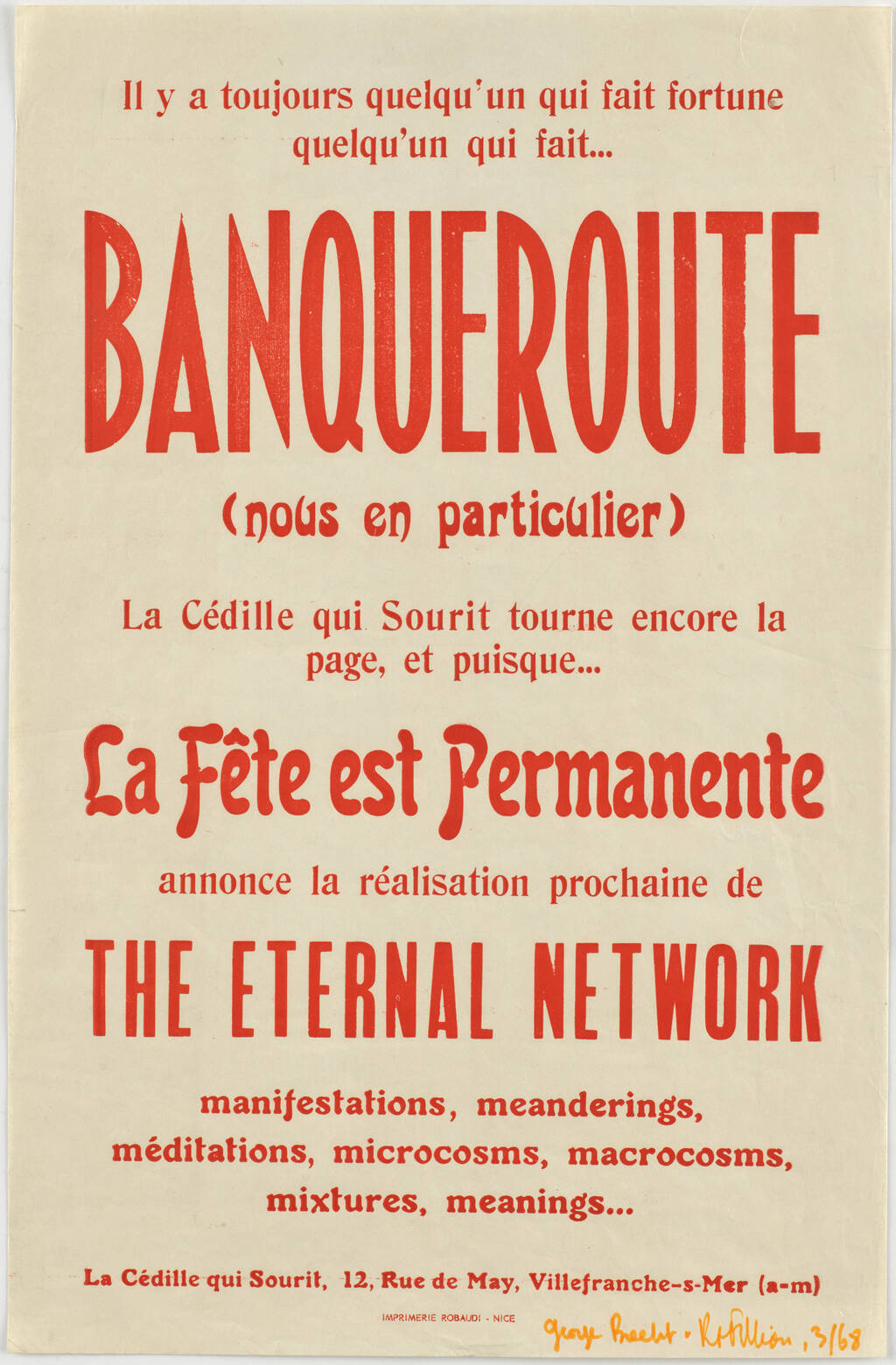
Or A New Way to Give People Headaches, also from MOMA’s collection:
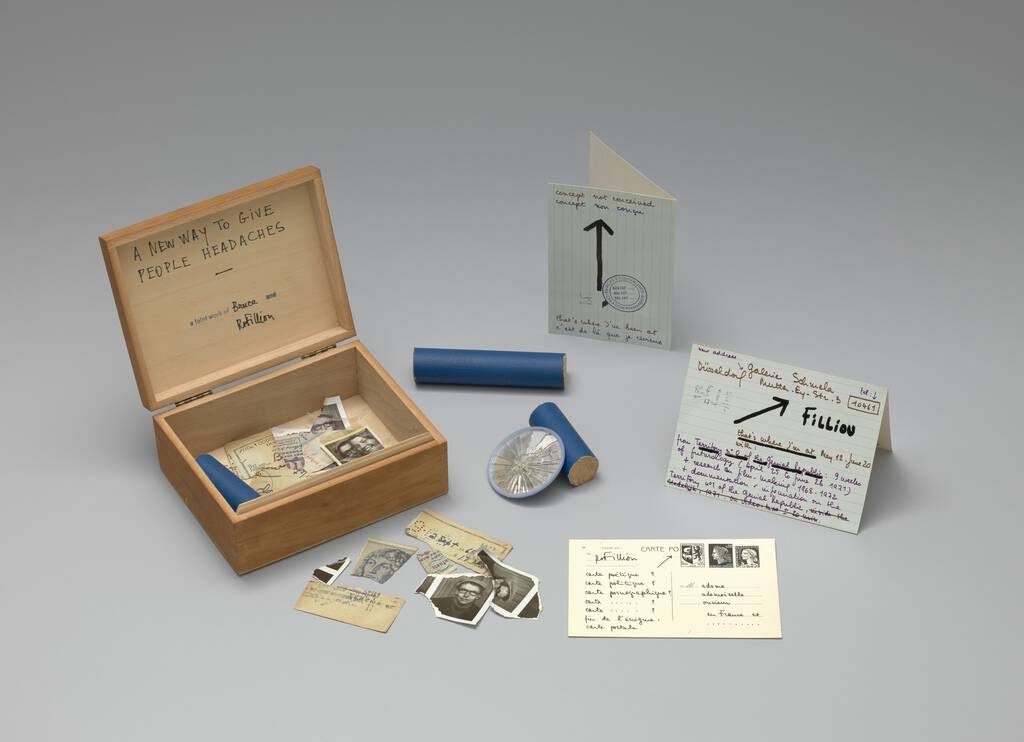
My favourite work, however, is the La Cédille qui sourit, produced for a 1969 exhibition of the same name at Städtisches Museum, Mönchengladbach:
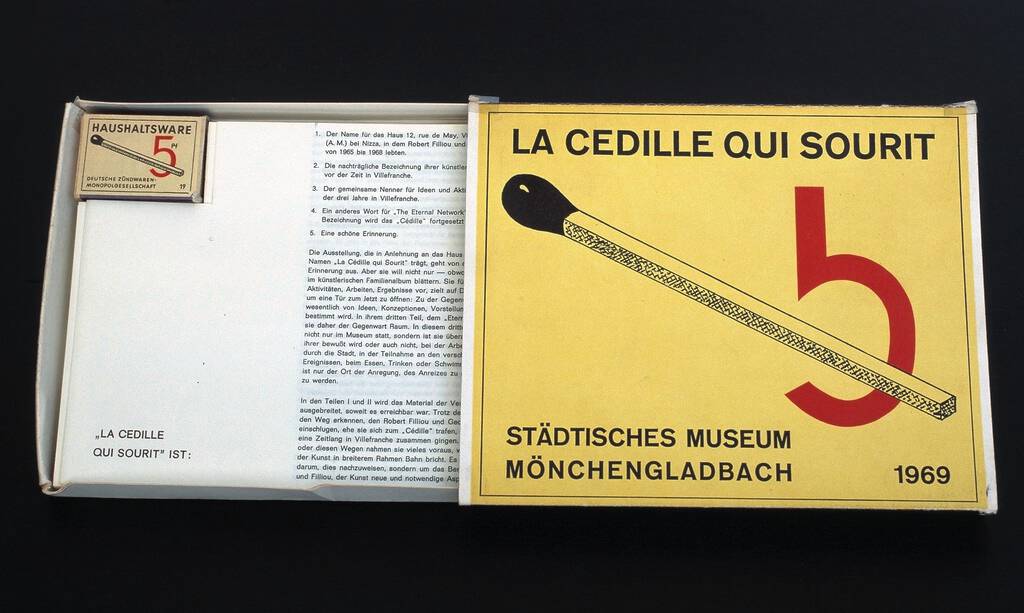
From notes about the piece in the M HKA Ensembles collection:
The choice of the dimensions of this box was part of the Städtisches Museum catalogue editing policy and the idea of the matchbox extra large came from the director of the museum Johannes Cladders. The box contains a text by Johannes Cladders, a list of works by Filliou and Brecht from before their collaboration, a list of their works made during their stay in Villefranche and the workingspot ‘La Cédille qui sourit’ (1965-1968) and some iconogeaphic cards with the headmark of ‘La Cédille qui sourit’ and some invitations to participate in the making of an anthology of jokes by returning postcards.
This is a piece that demands an homage, and so I set out to create one this weekend. This is what resulted:
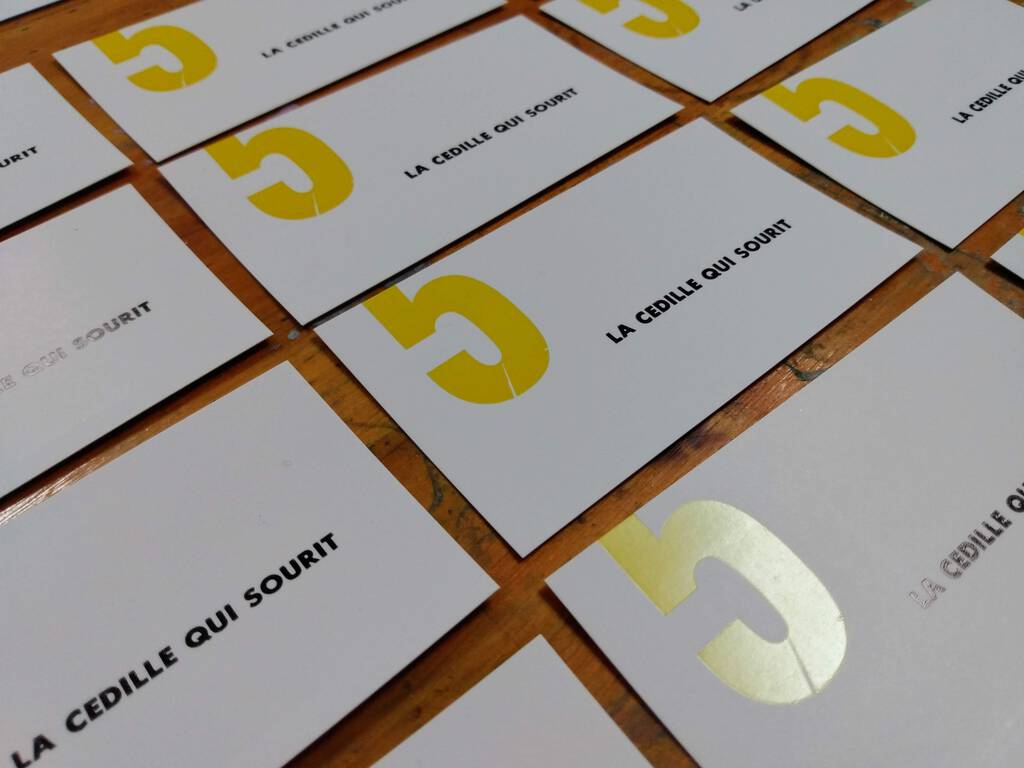
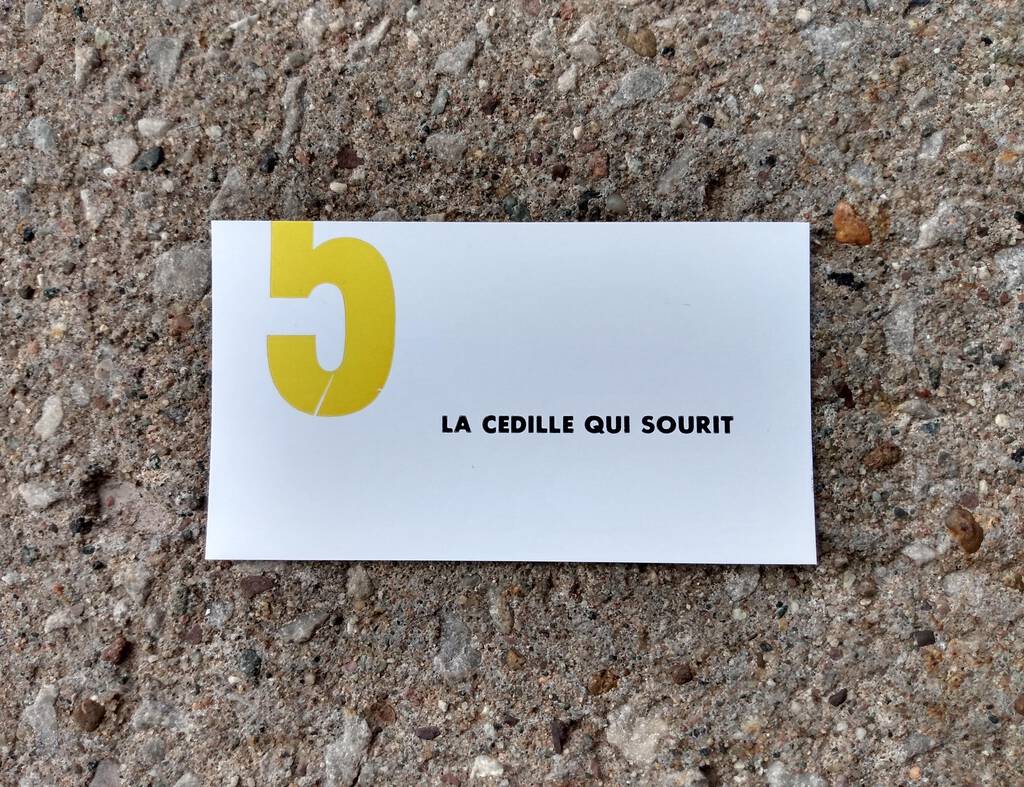
I printed fifty 90 mm by 55 mm cards on white coated cardstock (from the Bill & Gertie Campbell collection). The cédille itself is a hack–a beheaded “5” in 120 point Akzidenz Grotesk, printed in yellow ink from Southern Ink in Austin, TX. The text is printed in Southern Ink “dense black” in the 10 point sans serif face I picked up at the Museum of Printing last month.
If you would like one, PayPal me postage ($2 CAD for Canada, $2 USD for USA, €2 for international) and I’ll pop one in the mail to you.
When the community gathered to remember Josh and Oliver Underhay two weeks ago, Josh’s wife Karri, and his brother and sister, Mitch and Sara, asked people to share how they met Josh:
Both Shea and the Underhay siblings urged members of the community to share with them memories of Josh and Oliver.
“Everyone here has that story of the first time they met Josh. We don’t. We don’t have that. Josh was as real as gravity,” Mitch said.
I met Josh only once, on November 8, 2018. He was one of the “Old Greens” at a meeting of the Young Greens. He was already the candidate for District 9, and was there to talk to those-under-30 assembled about how they could help with the Green campaign and, more generally, what being a member of the Green Party meant.
Being old, and not-yet-even-Green myself–I was only there to support my son being there–I was loathe to do anything more than quietly sit in the back corner, biting my tongue against the urge to comport myself as a wise elder.
But Josh introduced himself to me, and we had a chat about water and electricity and open data. We made tentative plans to get together to talk in more detail.
Then, save for spotting him playing the trumpet at a Green event in Summerside the week he died, I never laid eyes on him again.
The day after Josh and Oliver died I was at Green Party headquarters on Water Street when a group returned from the Haviland Club where friends had gathered to support each other.
I don’t believe I’ve ever seen sadness etched as deeply on faces, and that sadness, and the waves of sadness and remembrance, joy for two lives lived and unfathomable grief for their ending, became a proxy for me to come to understand more about Josh and Oliver. I didn’t know them but, through the eyes of others, I came to know their radiant reflections.
I have thought of Josh and Oliver many times a day in the weeks since, and I’ve been working to try to find a way to channel those feelings away from two dimensional sadness into three dimensional promise. Karri pointed the way in her words at the gathering:
Since the accident, Shea said many have asked her what they can do to help her and her three-year-old son Linden.
“Here’s my answer: Please don’t let their deaths be only a senseless tragedy,” Shea said.
“Let them be a call to action and a catalyst for a change that you make in your life. For Prince Edward Island, for the world. Plant a tree, donate blood, put solar on your roof, buy an electric car.
“Build a bike path, Charlottetown.”
Shea also urged supporters to “love wildly and with abandon” in memory of her son Oliver.
Last week, on Saturday, I was heading to the Farmer’s Market by myself. It was slightly overcast, but not raining. Spring was in the air. So I pulled my bicycle out of the basement, pumped up the tires, and rode up University Avenue to the market, rather than taking the car.
Last Monday I stopped at MacQueen’s Bike Shop after my morning school run to talk to them about the possibilities of human-powered transport for getting myself, son, and service dog from downtown to Stars for Life this summer.
On Wednesday I joined the Green Party of Canada and resolved to help get Greens elected federally this fall.
On Friday I offered to join a provincial Green committee that’s setting out to make policy about making policy.
I’ve finally broken the habit of letting the water run while I’m brushing my teeth.
What I have started to do, in my daily life, is that when I’m faced with small forks in my road–take the car or take the bike? watch TV or join a committee? have a nap or call my mother? order pizza or learn to make pizza?–I will take the fork that, while it might be a little harder, require a little more effort, might take me out of the realm of things I’m comfortable doing, is the fork that’s best for my family, my community, and the planet.
In all such decisions, standing at those forks, there’s a little burst of energy needed to launch out of the orbit of habit and comfort.
I’ve come to call that little burst of energy an Underhay.
And that, for me, has been the way forward.

Speaking of the Legislative Assembly of PEI, while I cannot recall any Member of the Legislative Assembly, or member of the public at large, being imprisoned by the Assembly, during our 26 years living here, there was the affair of December 30, 1999 when Leader of the Opposition Paul Connolly was suspended from the Legislature for five days.
Mr. Connolly had proposed a motion regarding Child Maintenance Support:
BE IT RESOLVED that the matter of financial support to Island children by their non-custodial parents (child maintenance support), be REFERRED to the Standing Committee on Social Development for study and review, and that affected families be given an opportunity to present their views and concerns to the Standing Committee.
The motion was defeated, Mr. Connolly was incensed, tipped over his desk, and the Speaker “named” him, instructing the Sergeant-at-Arms to remove him:
Speaker: Please leave the floor immediately. Sergeant-at-Arms remove the Honourable Member.
Leader of the Opposition: I’m doing everything I can to contain myself.
Speaker: I ….. wait until he leaves. Remove the Honourable Member please, immediately.
An Honourable Member: Get out.
Speaker: Honourable Members, I have named the Honourable Member. I’m asking for a Motion that the Honourable Member be suspended for a period of time from the Legislature.
Several Honourable Members: Agreed
Once Connolly was removed, Pat Mella, at the time Minister of Finance, rose on a point of order, and described what had happened:
Hon. Pat Mella (PC): Eventually he did, that’s true. But in the…in going from the House he tipped over another chair. He obviously… I know he was very upset, but we have to have some decorum in the Legislative Assembly. This is a serious….what if he had thrown something. Like I don’t think this a verbal outburst, I know that there are…. I’m not suggesting that there shouldn’t be harder penalties perhaps for verbal outbursts as well, but I don’t see this as the same thing. And I think that we should…I think I’ll let the Premier speak to this but I think that we should ask for the penalty for the member, and I don’t think we should try to argue that there are similar things. I’ve been in the House since 1993, apart from the bombing, I have never seen physical… such a physical action with inside the Legislative Assembly. I think it’s a serious offense. And with all due respect to the member, I think that we have to do something about it.
Ms. Mella subsequently moved that Connolly be suspended for 5 days, and that motion was carried.
Paul Connolly was, by almost every report, a skilled and effective legislator, and his outburst seems to have been completely out of character. The following day the CBC reported that he had formally apologized:
“As an MLA for 17 years, I have enormous respect for the Legislature. Again, I regret my actions of Tuesday evening. I should not have allowed by anger at the Government’s lack of responsiveness to overwhelm the decorum which must govern our activities as Members of the Legislative Assembly,” he said.
There has been much talk in the U.S. media of late about the possibility that the House of Representatives might vote to hold Attorney General William Barr in contempt of congress, leading to speculation about whether Barr could be jailed as a result.
This made me curious about what powers legislators here in Prince Edward Island have along the same vein, and the answer can be found in Section 10 of the Legislative Assembly Act:
11. Common jail
The common jail of the County of Queens is the prison of the Legislative Assembly. R.S.P.E.I. 1974, Cap. L-11, s.11.12. Committal to prison, who may be
The Legislative Assembly may commit to prison any person adjudged, by resolution of the Legislative Assembly, guilty of any contempt or breach of its privileges, and the Sergeant-at-Arms of the Legislative Assembly shall carry out any order of the Legislative Assembly under this section. R.S.P.E.I. 1974, Cap. L-11, s.12.13. Receiving persons into custody and confinement
The keeper of the common jail of the County of Queens shall receive into his custody and confine in the jail all such persons as shall be committed to the jail, under and by virtue of any warrant signed by the Speaker of the Legislative Assembly. R.S.P.E.I. 1974, Cap. L-11, s.13.
The “common jail of the County of Queens” is, apparently, the Provincial Correctional Centre in Charlottetown, otherwise known as “Sleepy Hollow.” Brian Weldon currently holds the office of Sergeant-at-Arms.
Members of the Legislative Assembly allege that one of their peers is in contempt of the House surprisingly often, although a casual review of Hansard suggests, these allegations rarely result in imprisonment.
The language in the Legislative Assembly Act can be found, in almost the same wording, in the earlier An Act respecting the Legislature from 1893, which reads, on the topic:
8. The common jail of the County of Queen’s shall be the prison of the Legislature.
9. The Assembly shall have full power to commit to prison any person who shall, by resolution of the said Assembly, be adjudged guilty of any contempt or breach of its privileges, and the Sergeant-at- Arms of the said Assembly shall be the officer to carry out any order of said Assembly, made under this section.
10. It shall be the duty of the keeper of the common jail of the said County of Queens to receive into his custody, and confine in such jail, all such persons as shall at any time be committed to such jail under and by virtue of any warrant signed by the Speaker of the Assembly. All justices of the Peace, Sheriffs, Deputy Sheriffs, jailers, Constables and other officers, shall aid and assist the said Assembly whenever required so to do.
The federal Minister of Justice, John S. D. Thompson, took exception to these powers in his review of the Act:
It has been established by many decisions that a local or colonial Legislature does not, in the absence of express grant from the Imperial Parliament, possess punitive powers, and it is, in the opinion of the undersigned, not competent for such a Legislature to confer upon itself or one of its constituent bodies powers such as those in question.
That that language of the Act has persevered to this day suggests that the Minister’s cautions were not heeded, perhaps because Thompson, who was also Prime Minister, died eight months later (at Windsor Castle, while visiting Queen Victoria).
Continuing my exploration of OpenStreetMap as a database, I was curious to know how many buildings are on the map on Prince Edward Island, and how many OpenStreetMap users are responsible for having created them.
To extract the buildings I used this Overpass Turbo query:
[out:json][timeout:25];
{{geocodeArea:Prince Edward Island}}->.searchArea;
(
way["building"](area.searchArea);
);
out meta;
>;
out skel qt;
I saved the resulting JSON output as buildings-on-pei.json; here’s what a single building looks like in that file:
{
"type": "way",
"id": 28325849,
"timestamp": "2019-04-20T02:57:13Z",
"version": 22,
"changeset": 69393585,
"user": "ParagonPrime",
"uid": 1378289,
"nodes": [
311069933,
311069935,
311069936,
2145848876,
2145848878,
4265414120,
2603563172,
311069941,
3933036109,
311069933
],
"tags": {
"addr:city": "Charlottetown",
"addr:housename": "Confederation Centre of the Arts",
"addr:housenumber": "145",
"addr:postcode": "C1A 1J1",
"addr:street": "Richmond Street",
"building": "yes",
"building:levels": "0",
"building:levels:underground": "1",
"level": "-1",
"name": "Confederation Centre of the Arts",
"roof:colour": "gray",
"roof:material": "stone",
"tourism": "attraction",
"website": "https://www.confederationcentre.com/en/",
"wheelchair": "yes",
"wikidata": "Q5159778",
"wikipedia": "en:Confederation Centre of the Arts"
}
}
Note that there is a “user” element; I can use that to identify who created–or, to be more accurate, who last updated–each of the buildings.
First, I get a count of the number of buildings in the file:
# grep '"user"' buildings-on-pei.json | wc -l
14395
Next, I get a count of the number of buildings attributed to each user:
# grep '"user"' buildings-on-pei.json | sort | uniq -c | sort -rn
5069 "user": "MaestroGlanz",
2841 "user": "Peter Rukavina",
2816 "user": "Alecs01",
996 "user": "Alan Bragg",
684 "user": "mariadalton",
534 "user": "the506",
335 "user": "506imports",
159 "user": "Matthew Darwin",
143 "user": "dankpoet",
129 "user": "kalebmcneil",
72 "user": "lokejul",
69 "user": "Rps333",
57 "user": "TristanA",
57 "user": "ParagonPrime",
57 "user": "Gamer Gig",
53 "user": "PurpleMustang",
34 "user": "maTH5M2b",
31 "user": "Bennard",
28 "user": "Zeflind",
20 "user": "allain_2",
18 "user": "b-jazz-bot",
12 "user": "Himké",
10 "user": "dkunce",
10 "user": "Michel G Arsenault",
10 "user": "Kenfee3",
8 "user": "CanuckGeographer",
7 "user": "andrewpmk",
6 "user": "binhex",
6 "user": "Timothy Smith",
6 "user": "StealthNinja51",
5 "user": "november3000",
5 "user": "fixedbusiness",
5 "user": "RobJN",
5 "user": "NoahUCD",
5 "user": "Neeko",
4 "user": "timdine",
4 "user": "PelleB",
3 "user": "xybot",
3 "user": "wheelmap_visitor",
3 "user": "smb1001",
3 "user": "ionutr_telenav",
3 "user": "hhcfw",
3 "user": "fx99",
3 "user": "Super-Map",
3 "user": "Little Brother",
3 "user": "DannyMcD",
3 "user": "Bryson",
2 "user": "petersfreeman",
2 "user": "ngillis",
2 "user": "mjf87nl",
2 "user": "kartler175",
2 "user": "huoju",
2 "user": "boute002",
2 "user": "Todd Gallant",
2 "user": "PipoCanaja",
2 "user": "Narcissus",
2 "user": "JamieeR",
2 "user": "FvGordon",
2 "user": "Cynthia King",
2 "user": "Bootprint",
2 "user": "Be A Mapper",
2 "user": "AndyJBlack",
1 "user": "yumoon",
1 "user": "vbertola",
1 "user": "ti-lo",
1 "user": "thetornado76",
1 "user": "sjharper",
1 "user": "shang 289",
1 "user": "scruss",
1 "user": "safirat",
1 "user": "pingoo",
1 "user": "ldgallant14",
1 "user": "landblend",
1 "user": "have moicy",
1 "user": "carlb",
1 "user": "b-jazz",
1 "user": "ansis",
1 "user": "Sammyhawkrad",
1 "user": "RRW",
1 "user": "Oliver Rukavina",
1 "user": "Kelly Rayner",
1 "user": "HitFilmMan",
1 "user": "Gabe Groner",
1 "user": "EzekielT",
1 "user": "Cranberry",
1 "user": "CanvecImports",
1 "user": "Ashenzari",
There are 87 OpenStreetMap users responsible for adding those 14,395 buildings to the map, with the busiest contributor being MaestroGlanz.
I made my 25th blood plasma donation at Canadian Blood Services today and received this pin from my nurse:
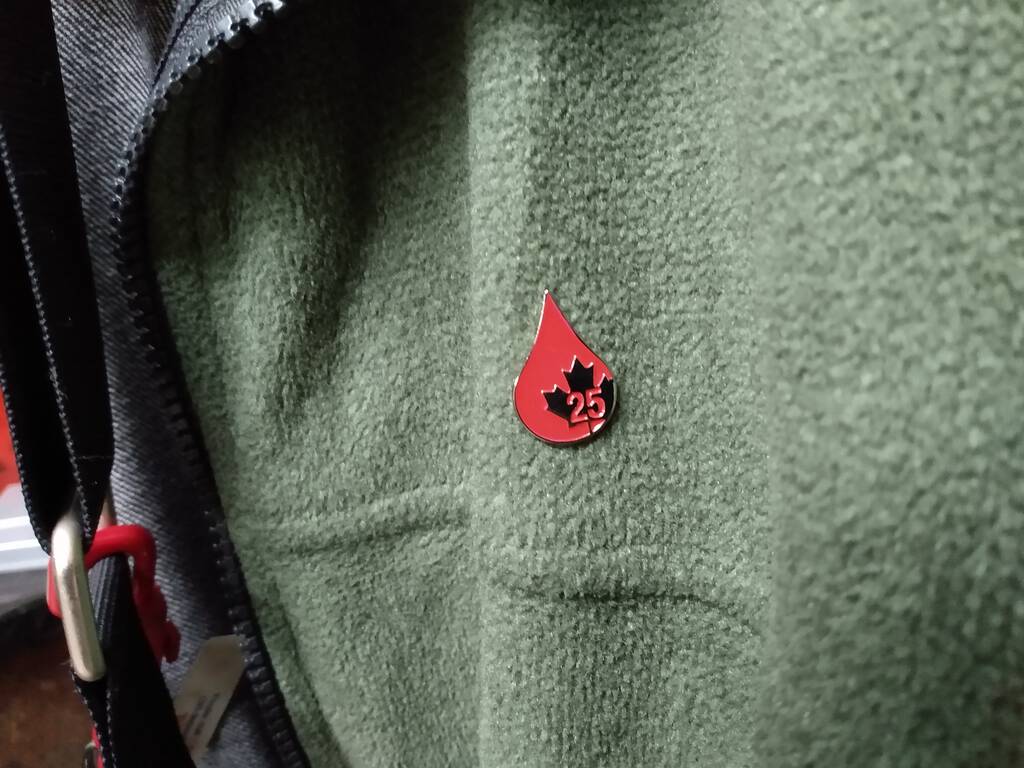
It takes me less than 90 minutes a month to donate plasma; in part it’s how I mark the passage of time. If you’re able to donate, I encourage you to do so: call 1 888 2 DONATE and they’ll hook you up.
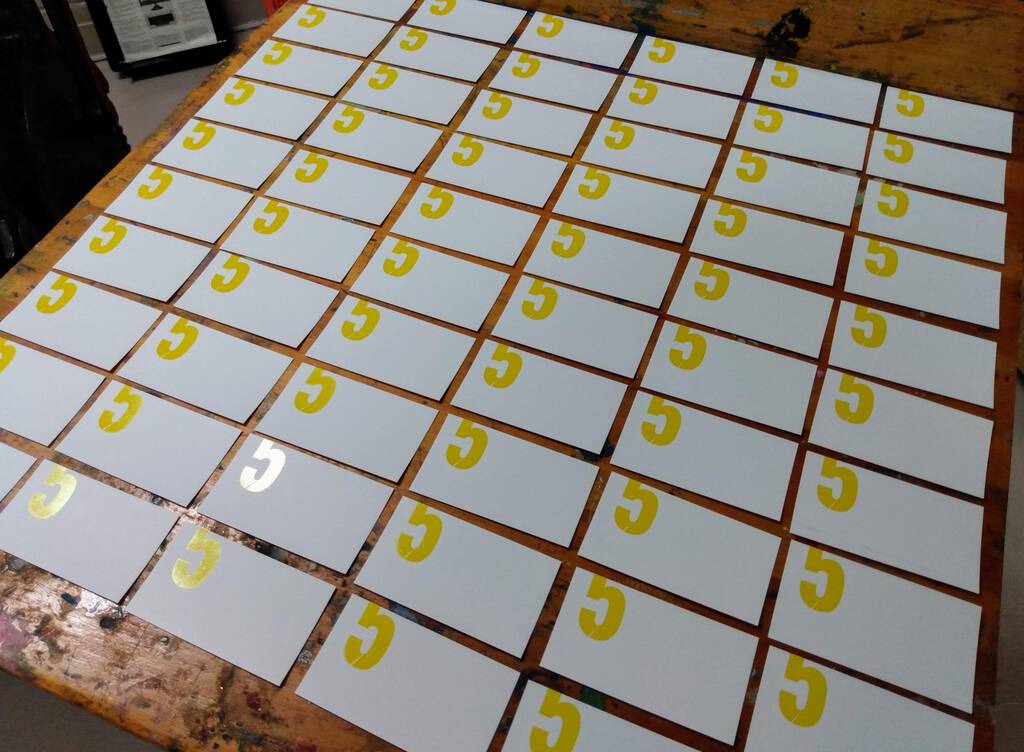
 I am
I am